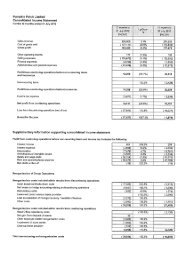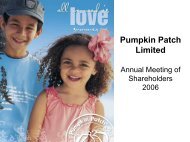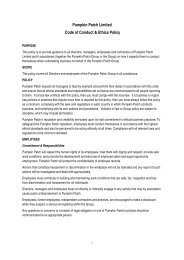annual report - Pumpkin Patch investor relations
annual report - Pumpkin Patch investor relations
annual report - Pumpkin Patch investor relations
You also want an ePaper? Increase the reach of your titles
YUMPU automatically turns print PDFs into web optimized ePapers that Google loves.
PUMPKIN PATCH LIMITED & SUBSIDIARIES NOTES TO THE FINANCIAL STATEMENTS 31 JULY 2010<br />
PUMPKIN PATCH LIMITED & SUBSIDIARIES NOTES TO THE FINANCIAL STATEMENTS 31 JULY 2010<br />
2 SUMMARY OF SIGNIFICANT ACCOUNTING POLICIES continued<br />
(G) INCOME TAX<br />
The income tax expense or revenue for the period is the total of the current periodÕs taxable<br />
income based on the income tax rate for each jurisdiction plus/minus any prior yearsÕ<br />
under/over provisions, plus/minus movements in the deferred tax balance except where<br />
the movement in deferred tax is attributable to a movement in reserves.<br />
Deferred tax assets and liabilities are recognised for temporary differences at the tax rates<br />
expected to apply when the assets are recovered or liabilities are settled, based on those<br />
tax rates which are enacted or substantively enacted for each jurisdiction. No deferred tax<br />
asset or liability is recognised in relation to these temporary differences if they arose in a<br />
transaction, other than a business combination, that at the time of the transaction did not<br />
affect either accounting profit or loss or taxable profit or loss.<br />
Deferred tax assets are recognised for deductible temporary differences and unused tax<br />
losses only to the extent that is probable that future taxable amounts will be available to<br />
utilise those temporary differences and losses.<br />
The income tax expense or revenue attributable to amounts recognised directly in equity<br />
are also recognised directly in equity.<br />
(H) GOODS AND SERVICES TAX (GST)<br />
The Income Statement has been prepared so that all components are stated exclusive of<br />
GST. All items in the balance sheet are stated net of GST, with the exception of receivables<br />
and payables, which include GST invoiced.<br />
(I) LEASES AND DEFERRED LANDLORD CONTRIBUTIONS<br />
Leases in which a significant portion of the risks and rewards of ownership are retained by<br />
the lessor are classified as operating leases. Payments made under operating leases are<br />
charged to the Income Statement on a straight-line basis over the period of the lease.<br />
Where a landlord makes a contribution to the initial setup cost of a store, the contribution<br />
is captialised. The contribution is amortised on a straight line basis over the life of the lease<br />
offsetting the lease payments made.<br />
(J) IMPAIRMENT OF NON FINANCIAL ASSETS<br />
Assets that have an indefinite useful life are not subject to amortisation and are tested<br />
<strong>annual</strong>ly for impairment. Assets that are subject to amortisation are reviewed for impairment<br />
whenever events or changes in circumstances indicate that the carrying amount may not<br />
be recoverable. An impairment loss is recognised for the amount by which the assetÕs<br />
carrying amount exceeds its recoverable amount. The recoverable amount is the higher<br />
of an assetÕs fair value less costs to sell and value in use. For the purposes of assessing<br />
impairment, assets are grouped at the lowest levels for which there are separately<br />
identifiable cash flows.<br />
(K) CASH AND CASH EQUIVALENTS<br />
Cash and cash equivalents includes cash on hand, deposits held at call with financial<br />
institutions, other short-term, highly liquid investments with original maturities of three months<br />
or less that are readily convertible to known amounts of cash. Bank overdrafts are shown<br />
within interest bearing liabilities in current liabilities on the balance sheet.<br />
(L) TRADE RECEIVABLES<br />
Trade receivables are recognised initially at fair value and subsequently at amortised<br />
cost less provision for doubtful debts.<br />
Collectibility of trade receivables is reviewed on an ongoing basis. Debts which are known<br />
to be uncollectible are written off. A provision for doubtful receivables is established when<br />
there is objective evidence that the Group will not be able to collect all amounts due<br />
according to the original terms of receivables. The amount of the provision is the difference<br />
between the assetÕs carrying amount and the present value of estimated future cash flows.<br />
The amount of the provision is recognised in the Income Statement.<br />
Significant financial difficulties of the debtor, probability that the debtor will enter<br />
bankruptcy or financial reorganisation, and default or delinquency in payments are<br />
considered indicators that the trade receivable is impaired.<br />
(M) INVENTORIES<br />
Work in progress and finished goods are stated at the lower of cost and net realisable<br />
value. Costs are assigned to individual items of inventory on the basis of weighted average<br />
costs, and includes expenditure incurred in acquiring the assets and bringing them to their<br />
existing location and condition. Net realisable value is the estimated selling price in the<br />
ordinary course of business.<br />
(N) DERIVATIVES<br />
Derivatives are initially recognised at fair value on the date a derivative contract is entered<br />
into and are subsequently remeasured to their fair value. The method of recognising the<br />
resulting gain or loss depends on whether the derivative is designated as a hedging<br />
instrument, and if so, the nature of the item being hedged. The Group designates certain<br />
derivatives as either; (a) hedges of the fair value of recognised assets or liabilities or a firm<br />
commitment (fair value hedge); or (b) hedges of highly probable forecast transactions (cash<br />
flow hedges).<br />
The Group documents at the inception of the transaction the <strong>relations</strong>hip between hedging<br />
instruments and hedged items, as well as its risk management objective and strategy for<br />
undertaking various hedge transactions. The Group also documents its assessment, both<br />
at hedge inception and on an ongoing basis, of whether the derivatives that are used<br />
in hedging transactions have been and will continue to be highly effective in offsetting<br />
changes in fair values or cash flows of hedged items.<br />
20<br />
years<br />
young<br />
49












